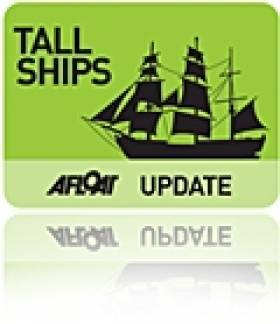Displaying items by tag: Seafair Haven
The Return of the 'Wexford' Tall-Ship
A grant of €1m from Fáilte Ireland was allocated towards the cost of the refit as part of the National Development Plan (NDP). Visitors can now take guided tours of the floating tourist attraction though access to the shoreside visitor centre remains closed due to an upgrade. Work on an extension of a new exhibition centre is expected to be completed in May or June.
Dunbrody is a full scale reconstruction of the 19th century replica famine-ship based on the vessel built in 1845 in Quebec, Canada for the Graves family of New Ross. Ireland's most inland port being made famous with the visit of President John F. Kennedy in 1963 to the same quayside where Dunbrody is berthed.
To date the Dunbrody's presence outside her homeport has been scarce. During the Waterford Tall Ships Festival in 2005 she took part in a memorable and historic 'Parade of Sail' where she formed as part of the trio of Irish tall ships that met together for the only time. The sailing spectacle of the international fleet was headed firstly by the Irish trio with Asgard II leading followed by Dunbrody and astern the Jeanie Johnston.
In the following year Dunbrody made her maiden and only international voyage to Milford Haven in south Wales. The Pembrokeshire estuary had hosted the new festival, Seafair Haven. On that occasion she had the honour of leading another parade of sail, under the command of Captain Tom McCarthy.
Dunbrody was last dry-docked in 2006 and also at the New Ross boatyard which lies on the Co. Kilkenny side of the riverbank. The 176 foot / 54 metre barque was built in 2001 and was last vessel completed at the boatyard. During her building the public could access the yard and the construction process could be viewed from above at a gallery set within the covered building hall.
The structure no longer exists but which was built originally for the Ross Company boatyard during the 1970's. The yard specialised in building barge pontoons for markets in the North Sea until the premises closed in the 1980's. In recent years and under new management the dry-dock (75m X 15m) has been upgraded with a new gate and pump.
Looking for further reading on Tall Ships in Ireland? Click the links below:
Click this link to read all our Tall Ships Stories on one handy page
Previewing Ireland's Tall Ships 2011 Season
Can Ireland Get a New Tall Ship?
- Asgard II
- Jeanie Johnston
- river barrow
- New Ross
- River Suir
- Milford Haven
- Ports and Shipping News
- barque
- Fáilte Ireland
- Dunbrody
- Parade of Sail
- Brigantine
- Waterford Tall Ships Festival
- Dunbrody Heritage Centre
- River Nore
- New Ross Boat Yard
- Sea Haven
- National Development Plan
- NDP
- President John F. Kennedy
- Capt. Tom McCarthy
- Ross Company
- Seafair Haven





























































